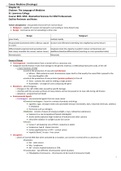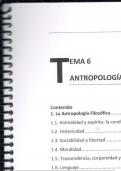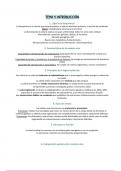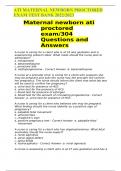Cancer Medicine (Oncology)
Chapter 21
Chabner: The Language of Medicine
St. Lawrence College
Course: BIOL 1050 - Biomedical Sciences for HIM Professionals
Outline Reviewer and Notes
Tumors (neoplasms) - new growths that arise from normal tissue
• Malignant - capable of invasion and spread to surrounding or more distant sites
• Benign - noninvasive and not spreading to other sites
Benign Malignant
grow slowly multiply rapidly
Encapsulated (contained within a fibrous capsule invasive and infiltrative (extending into neighboring normal tissue)
or cover)
Differentiated (organized and specialized cells Anaplastic (lack the capacity to perform mature cell functions) and
that closely resemble the normal, mature tissue) dedifferentiated/undifferentiated (reverting to a less specialized state)
Nonmetastatic Metastatic
Causes of Cancer
• Carcinogenesis - transformation from a normal cell to a cancerous one
• malignant transformation results from damage to the genetic material, or DNA (deoxyribonucleic acid), of the cell
o 2 main functions of DNA
• controls the production of new cells (cell division)
• Mitosis - DNA material in each chromosome copies itself so that exactly the same DNA is passed to the
two new daughter cells
• controls the production of new proteins (protein synthesis) in the cell
• Gene - contains the code for making a single protein
• Nucleotides - arranged of units composing the gene
• Mutations - abnormal genes
o Changes in the cell's DNA codes caused by specific damage
o interfere with the accurate synthesis of new proteins and can be passed on to new cells during cell division
o Apoptosis - programmed cell death
• Environmental Agents
o Carcinogens - environmental agents that can cause cancer
• Chemical carcinogens - found in a variety of products and drugs
• cigarette, cigar, and pipe smoke and automobile exhaust-insecticides, dyes, industrial chemicals, asbestos
in inhalation
• Hormones such as estrogens
• Radiation - consists of waves of energy (sunlight, x-rays, radioactive substances)
• Exposure to x-ray (occupational hazard radiologists)
• atomic bomb explosion (high incidence of leukemia and other cancers)
• ultraviolet radiation in sunlight causes skin cancer
• Viruses
• human T cell leukemia virus (HTLVl) - leukemia in adults
• herpesvirus type 8 - Kaposi sarcoma
• human papillomavirus or HPV - cervical cancer
• hepatitis Band C viruses - liver cancer
• Oncogenes
o pieces of normal DNA that when activated by a mutation, can convert a normal cell to a cancerous cell
• Examples:
• Ras - colon cancer
• Myc - lymphoma
• Abl - chronic myeloid leukemia or CML
• Translocation - two different chromosomes switch locations
• Philadelphia chromosome - chromosome 22 (bcr) and chromosome 9 (abl)
1
, Cancer Medicine (Oncology)
Chapter 21
Chabner: The Language of Medicine
St. Lawrence College
Course: BIOL 1050 - Biomedical Sciences for HIM Professionals
Outline Reviewer and Notes
• Hereditary
o Cancer also may be caused by transmission from parents to offspring through defects in the DNA of the egg or sperm
cells
• Examples:
• Retinoblastoma - tumor of the retina of the eye
• adenomatous polyposis coli syndrome - premalignant polyps that grow in the colon and rectum
• certain forms of colon, breast, and kidney cancer
• suppressor genes - inherited or acquired abnormalities in certain genes
• Examples:
• retinoblastoma (Rb) type 1 gene (RB1)
• TP53 gene
• genetic screening - family members may be tested to determine whether a person has inherited the
cancer-causing gene
•
Classification of Cancerous Tumors
• Histogenesis - identifying the particular type of tissue from which the tumor cells arise
• Major groups:
o Carcinomas
o Sarcomas
o Mixed-tissue tumors
Carcinomas - largest group
• solid tumors that are derived from epithelial tissue that lines external and internal body surfaces, including skin, glands, and
digestive, urinary, and reproductive organs
• Adenoma - Benign tumors of epithelial origin
• Carcinoma - Malignant tumors of epithelial origin
Sarcomas - malignant tumors but are less common than carcinomas
• derive from connective tissues in the body
• mesenchymal tissue - describe embryonic connective tissue from which sarcomas are derived
Mixed-tissue tumors - derived from tissue that is capable of differentiating into both epithelial and connective tissue
Gross Descriptions
cystic Forming large open spaces filled with fluid
• Mucinous tumors - filled with mucus (thick, sticky fluid)
• serous tumors - filled with a thin, watery fluid resembling serum
fungating Mushrooming pattern of growth in which tumor cells pile one on top of another and project
from a tissue surface
• Tumors found in the colon
inflammatory Having the features of inflammation-that is, redness, swelling, and heat
medullary Large, soft, fleshy tumors
necrotic Containing dead tissue
polypoid Growths that form projections extending outward from a base
• Sessile polypoid tumors - extend from a broad base
• pedunculated polypoid tumors - extend from a stern or stalk
ulcerating Characterized by an open, exposed surface resulting from the death of overlying tissue
verrucous Resembling a wart-like growth
2
Chapter 21
Chabner: The Language of Medicine
St. Lawrence College
Course: BIOL 1050 - Biomedical Sciences for HIM Professionals
Outline Reviewer and Notes
Tumors (neoplasms) - new growths that arise from normal tissue
• Malignant - capable of invasion and spread to surrounding or more distant sites
• Benign - noninvasive and not spreading to other sites
Benign Malignant
grow slowly multiply rapidly
Encapsulated (contained within a fibrous capsule invasive and infiltrative (extending into neighboring normal tissue)
or cover)
Differentiated (organized and specialized cells Anaplastic (lack the capacity to perform mature cell functions) and
that closely resemble the normal, mature tissue) dedifferentiated/undifferentiated (reverting to a less specialized state)
Nonmetastatic Metastatic
Causes of Cancer
• Carcinogenesis - transformation from a normal cell to a cancerous one
• malignant transformation results from damage to the genetic material, or DNA (deoxyribonucleic acid), of the cell
o 2 main functions of DNA
• controls the production of new cells (cell division)
• Mitosis - DNA material in each chromosome copies itself so that exactly the same DNA is passed to the
two new daughter cells
• controls the production of new proteins (protein synthesis) in the cell
• Gene - contains the code for making a single protein
• Nucleotides - arranged of units composing the gene
• Mutations - abnormal genes
o Changes in the cell's DNA codes caused by specific damage
o interfere with the accurate synthesis of new proteins and can be passed on to new cells during cell division
o Apoptosis - programmed cell death
• Environmental Agents
o Carcinogens - environmental agents that can cause cancer
• Chemical carcinogens - found in a variety of products and drugs
• cigarette, cigar, and pipe smoke and automobile exhaust-insecticides, dyes, industrial chemicals, asbestos
in inhalation
• Hormones such as estrogens
• Radiation - consists of waves of energy (sunlight, x-rays, radioactive substances)
• Exposure to x-ray (occupational hazard radiologists)
• atomic bomb explosion (high incidence of leukemia and other cancers)
• ultraviolet radiation in sunlight causes skin cancer
• Viruses
• human T cell leukemia virus (HTLVl) - leukemia in adults
• herpesvirus type 8 - Kaposi sarcoma
• human papillomavirus or HPV - cervical cancer
• hepatitis Band C viruses - liver cancer
• Oncogenes
o pieces of normal DNA that when activated by a mutation, can convert a normal cell to a cancerous cell
• Examples:
• Ras - colon cancer
• Myc - lymphoma
• Abl - chronic myeloid leukemia or CML
• Translocation - two different chromosomes switch locations
• Philadelphia chromosome - chromosome 22 (bcr) and chromosome 9 (abl)
1
, Cancer Medicine (Oncology)
Chapter 21
Chabner: The Language of Medicine
St. Lawrence College
Course: BIOL 1050 - Biomedical Sciences for HIM Professionals
Outline Reviewer and Notes
• Hereditary
o Cancer also may be caused by transmission from parents to offspring through defects in the DNA of the egg or sperm
cells
• Examples:
• Retinoblastoma - tumor of the retina of the eye
• adenomatous polyposis coli syndrome - premalignant polyps that grow in the colon and rectum
• certain forms of colon, breast, and kidney cancer
• suppressor genes - inherited or acquired abnormalities in certain genes
• Examples:
• retinoblastoma (Rb) type 1 gene (RB1)
• TP53 gene
• genetic screening - family members may be tested to determine whether a person has inherited the
cancer-causing gene
•
Classification of Cancerous Tumors
• Histogenesis - identifying the particular type of tissue from which the tumor cells arise
• Major groups:
o Carcinomas
o Sarcomas
o Mixed-tissue tumors
Carcinomas - largest group
• solid tumors that are derived from epithelial tissue that lines external and internal body surfaces, including skin, glands, and
digestive, urinary, and reproductive organs
• Adenoma - Benign tumors of epithelial origin
• Carcinoma - Malignant tumors of epithelial origin
Sarcomas - malignant tumors but are less common than carcinomas
• derive from connective tissues in the body
• mesenchymal tissue - describe embryonic connective tissue from which sarcomas are derived
Mixed-tissue tumors - derived from tissue that is capable of differentiating into both epithelial and connective tissue
Gross Descriptions
cystic Forming large open spaces filled with fluid
• Mucinous tumors - filled with mucus (thick, sticky fluid)
• serous tumors - filled with a thin, watery fluid resembling serum
fungating Mushrooming pattern of growth in which tumor cells pile one on top of another and project
from a tissue surface
• Tumors found in the colon
inflammatory Having the features of inflammation-that is, redness, swelling, and heat
medullary Large, soft, fleshy tumors
necrotic Containing dead tissue
polypoid Growths that form projections extending outward from a base
• Sessile polypoid tumors - extend from a broad base
• pedunculated polypoid tumors - extend from a stern or stalk
ulcerating Characterized by an open, exposed surface resulting from the death of overlying tissue
verrucous Resembling a wart-like growth
2











